I’ve shown you my California Mediterranean Cottage Garden, out front, and the Wish I Were A Woodland, out back. But, as we used to say, there’s moooooore. Behold The Blasted Wasteland.
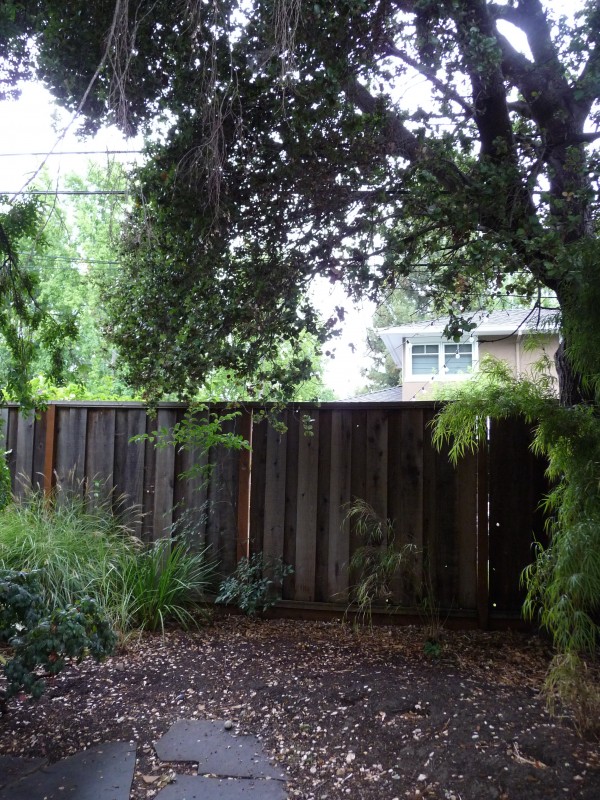
Sigh.
Here’s a story. Although somewhat specific to Northern California, I suspect that the plot elements, i.e. a need for privacy, a particular climate, and a forced shift in perspective revealing new choices, might be common to house-owners and gardeners everywhere.
See that neighboring house? It used to be 1-storey, hidden by their hedge. But they remodeled, as people will in the Land-Of-Ever-Soaring-Real-Estate-Prices. Then they cut down the plantings so as to have more lawn. I’ve been grumbling about it ever since.
Because I could now see their windows, and they could by inference see me cavorting round my back yard, I let a volunteering Coast Live Oak grow tall, as a screen. It did a good job. At first. But as it grew taller, I found myself the none-too-happy owner of a nicely framed view of someone else’s bedroom and a “Heritage Tree” that prevented anything I’d previously planted from growing in its shade.
Goodbye small magnolia, take a hike shrub rose.
I vowed to cut down the oak and plant something else. Something nicer. Something greener and tidier. But “Heritage Tree” in my community means applying to the city for permission to remove, or even prune more than 25%. It’s a good thing too. Given that enforced pause, that moment to settle myself and my annoyance, I stayed my hand. Good choice, but some problems in implementation.
On the one hand, the oak is happy, tall, and beautifully shaped. It also loves dry summers, and we’re in a deep drought. On the other hand, it’s a very demanding piece of vegetation. You can’t water underneath during the summer, you can’t dig around the roots, you can’t plant anything that doesn’t tolerate shade and an acid soil. Oh, and you have to welcome prickly oak leaves on the ground or you’ll lose your mind. So. What to do?
- Acknowledge your semi-arid climate
- Find yourself a knowledgeable resource
- Look up some California natives that do well in the actual ecosystem
Enter Las Pilitas Nursery. An incredible online resource for California native gardening. Really fun tongue-in-cheek plant writing too. I imagine you have a similar nursery for your region, somewhere that specializes in prairie grasses, or swamp-happy trees, or desert wildflowers that bloom once a century.
Here’s what I’m thinking. First, screen out the neighbors with a coffeeberry. It can grow up to 10 feet. Let’s hope.
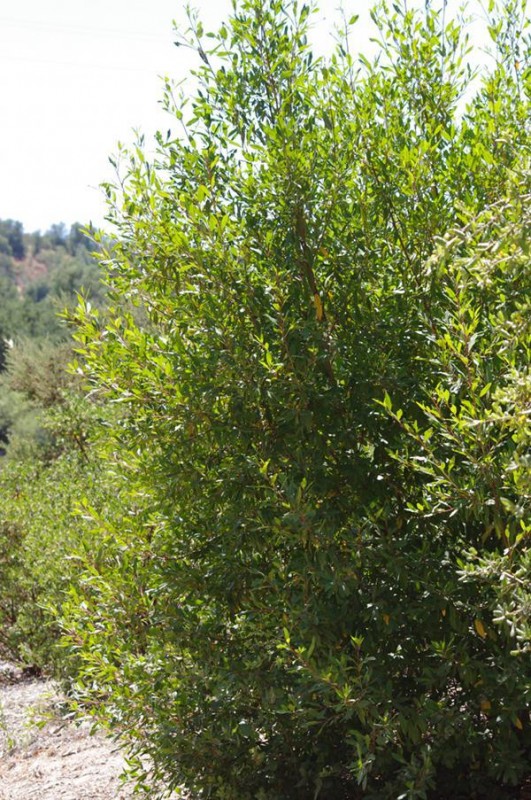
Then plant a low-growing manzanita variety as ground cover. I don’t want color beyond green, fall-reddening foliage, the occasional dark berry, and pale tinges of pink flowers.
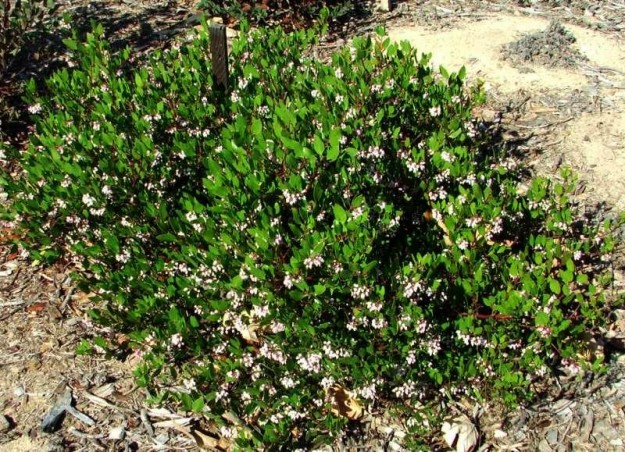
Finally, to rescue the magnolia from its oak-induced suffering, move it to the already-watered-regularly Woodland part of the yard. It may not survive the transplant, but it’s surely not going to make it through the Age Of The Oak. Replace with a Flowering Current. Ribes Indecorum indeed. Deciduous, but it’ll be under a tall and shrubby plum tree, and I think I’ll enjoy the branches emerging come winter.
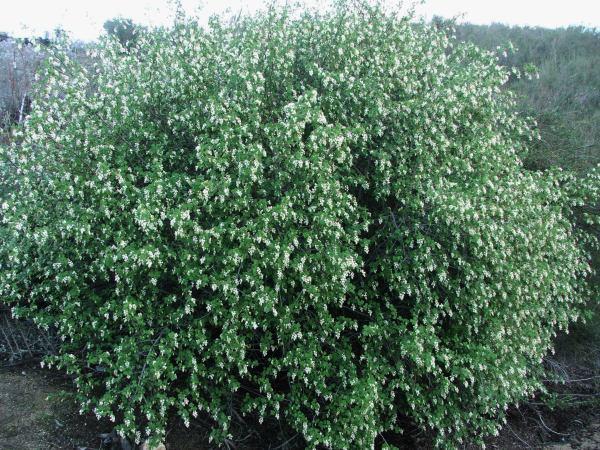
Gardening presents all sorts of challenges. But the hardest part for me is envisioning a design. I’m sure there are tools, but I can’t find them. So I’m improvising.
Using Photoshop Elements in a rankly amateurish fashion, I pasted some images from the Las Pilitas site over my photo at top. Go coffeeberry go. I will have to be very careful in the planting, as this will be situated “under the dripline,” as I am learning to say. I’ll to have some conversations with Las Pilitas to see if this will work.
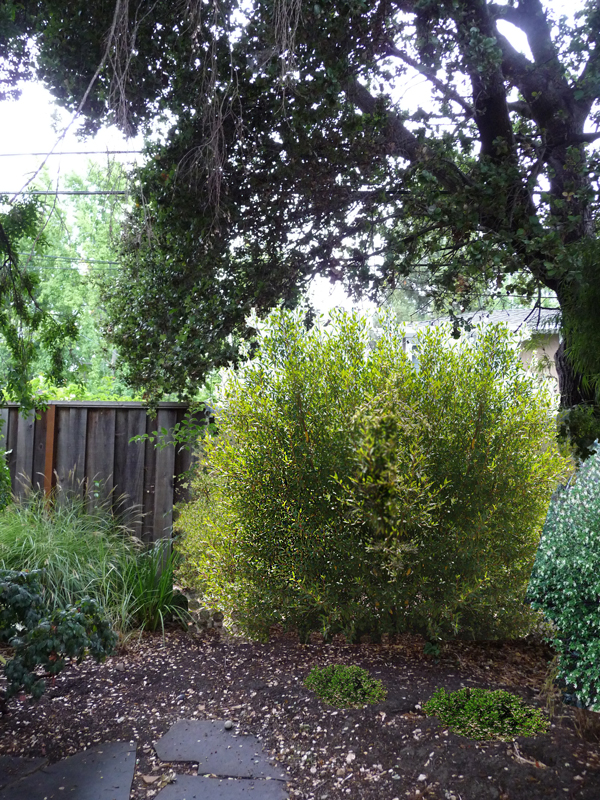
The surprise? Constraints, as often in creative endeavors, reveal new beauties. Hiding a bedraggled fence reveals the beauty of a stark little landscape. In this picture, the pattern of the fallen oak leaves on bare ground become part of the design. Sort of like negative space on a page layout. Intentional and enjoyed.
Besides, if I keep the oak, I keep this view. Do you all like to look up under the canopies of trees? I read somewhere that the random geometries of nature soothe our souls and I believe it.
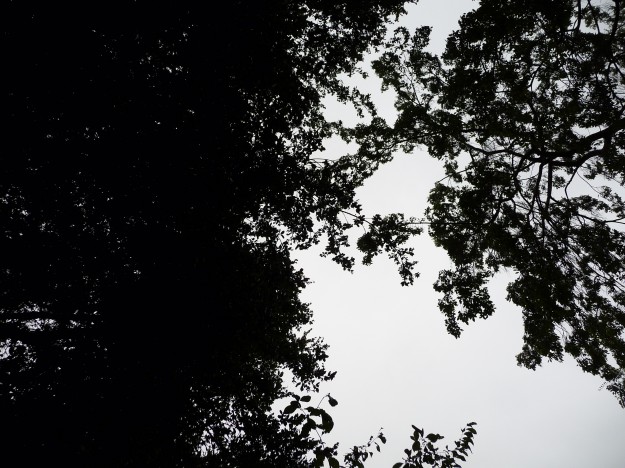
It looks like a good plan from the rescued tree’s perspective too, looking back at the house. Listen to your plants, says the oak, we may know what we are doing.
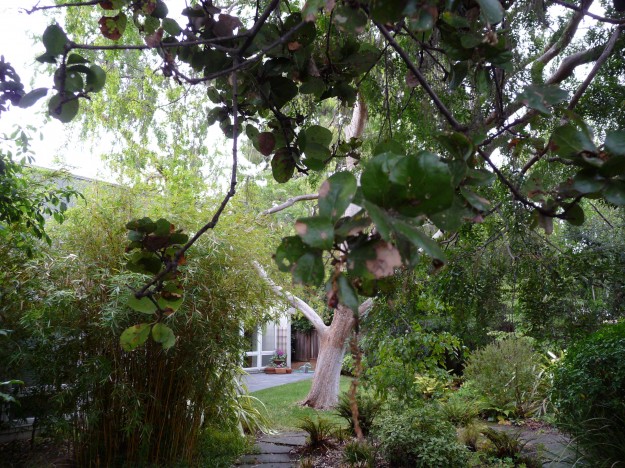
And to Robin Williams’ family, we are so sorry for your loss.

33 Responses
Yes to the manzanita! It’s native to that area and should co-exist nicely with the oak. Did you know it’s called the “Mile Away Tree”? (because you can see that bright red bark from some distance.) As someone who LOVES trees and would only remove under the most extreme circumstances (drat those pine bark beetles) I’m glad you’ve decided to keep the oak.
I love that, mile away. And I love trees too, I guess I just finally listened.
I understand so little about gardening – Beloved is the gardener in our household – that I can’t even begin to comment intelligently on this post. Now, having said that, your Photoshop skills are better than you might think – I like the layout of your imagined garden. It should be lovely.
Why thank you!
So glad that the oak stayed. We have quite a few large trees left in our yard, and we review their continued presence every few years. So far, we’ve had to remove two very large cedars (woodpeckers first hinted that their core was rotting out and we had an arborist confirm) and are now debating a large fir. We’ve unintentionally embarked on an eternal process of pollarding a few maples that volunteered in bad places. And the arbutus (madrona down your way) get a free pass wherever they grow as they’re so gorgeously barked, if messy). I’m glad there is some daunting bureaucracy in place, finally, around their removal. And, as you suggest, Mother Nature knows a thing or two about landscaping if we just adjust our expectations a bit. A fun post and I think your Photoshop skills are impressive. It’s going to be fun being a Ribes sanguinea ‘white icicles’ twin with you.
It’s ongoing, this tree business. And shrub twins we shall be! I’m really looking forward to this. Have to get the tree pruned etc. first, along with some other tree work in the yard, but should be ready to plant by fall.
The coffeeberry looks nice in the photo.
It’s described as doing well in sun to partial shade, so probably it’s not going to look quite as lush under your oak but why not give it a try!
True about the light – I am hoping the the general brightness will compensate somewhat for lack of direct sun.
I’m always surprised when I visit my SoCal daughter that Californians don’t use more mulch. It always seems thats lacking in a place where moisture needs to be conserved, but maybe there is a reason I don’t understand. The photos look lovely, and all that seems lacking to me is an attractive mulch, and a nice place to sit so that you can look up into that live oak and sigh with contentment.
Oaks need a very basic and unworked soil. So you have to use their own leaves as the mulch. Southern California is a different climate, almost a different state, really, so I am sadly ignorant about their gardening practices:).
Ah yes, “a nice place to sit” – a little hardscaping where nothing will or should grow. I picture a little cafe table with two chairs, a vine covered trellis ( ivy or shade loving) to block that view… And you, with a latte, pen and paper… No electronics in this fantasy :)
A future post:).
I like your mock up. Hurray for native plants! The native plants in my little window garden are the only ones that survived our colder than normal winter.
@Emmaleigh504, Interesting! For example?
I like your mock-up and the plants seem lovely. I like the way they seem to transform the space, and the way thinking about space, and constraints, sometimes transforms our thinking.
@Mardel, Thank you. I was surprised by the transformation
I think the coffee berry hedge will be perfect – I have hedges planted all around our home to block things out. I use privet which is great, with nice little white flowers at times.
We have a huge California sycamore in our backyard that is like a canopy. It’s very near to the lap pool that we built and everyone wanted us to cut it down so the leaves didn’t drop into the pool etc. But we resisted, and I’m so glad we did.
So glad you’re leaving your beautiful oak!
@kathy, Thank you! I’d also considered African boxwood, which does well up here and is kind of like a privet, but think I’ll give the oak ecosystem a go. An adventure.
I’m so glad the coastal oak is staying. You have a talent for laying out your garden, nicely done. Have you considered the podocarpus gracilior hedge? They grow tall, bushy and require little maintenance.
@Candace, I have a podocarpus a little further down the fence – it’s just been so slow-growing:( It’s a cool tree though, very unique foliage.
Your green thumb is evolving…and the oak can anchor your garden.
You might like to plant some hygrangeas to compliment your white roses.
Yes serious condolences to Robin William’s family….so very sad.
@hostessofthehumblebungalow, I have hydrangreas! Shy ones, in the Woodland Forest. And still sad about Robin Williams. Still sad about Heath Ledger. Talent doesn’t save us from everything.
Bamboo anyone? That’ll screen the heck outta anything!!!
@cissy, Bamboo will screen the whole neighbourhood. And then take over the adjacent neighbourhood. It’s sooooo invasive.
@cissy, I have a big clump of bamboo closer to the house. It’s supposedly non-invasive, although after 6 years I’m starting to notice a few extra clumps forming.
I understand your dilemma as we have just taken down a dead tree and are now fully exposed to our neighbours’ bedroom window – all privacy gone! It’s the south side of the house so we do now have more sun into the garden. What to do? Decisions, decisions!! Your plans seem very sound and I’m with those who suggest a nice seat and table in the shade of the tree.
@sharemygarden, It would be really hard to go from a shade garden to one for sun. So much replanting! I like it when neighbors share the screening burden, everyone doing their part in the suburban vegetation plan.
Our next door neighbors have an oak tree and we have 100% shade under it. It is right up against the fence so half of it hangs over our yard. I can’t grow anything there. We leave it a pile of fallen oak leaves. I would love to see if this works. Maybe we could do it too!
@Cathy, I’ll be reporting back!
I love the idea of a coffee berry hedge. I would do everything possible to preserve privacy.
I’m no expert, and live and garden in the mid-Atlantic region. But a friend owns a property in Florida, and once upon a time planted a just few coffeeberry bushes. Admittedly, she only visits Florida a few times a year, but now has more coffeebery plants than she can keep up with. At least in Florida, they seem to self seed very freely.
nice picture and also have good idea ! Really nice
Comments are closed.